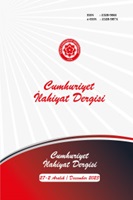Kur’ân’daki Tekrarların Nüzûl Dönemi Arapların Dili Kullanım Âdet ve Edebî Zevkleriyle İlişkisi
The Relationship of the Repetitions in the Qur’ān with the Language Usage Traditions and Literary Tastes of the Arabs of the Nuzūl Period
Author(s): Emrah DindiSubject(s): History of Islam, Theory of Literature, Sociology of Religion, History of Religion, Qur’anic studies, Sociology of Literature
Published by: Cumhuriyet Üniversitesi İlahyat Fakültesi
Keywords: Tafsīr; Qur’ān; Repetitions; Linguistic Customs of the Arabs; Literary Tastes;
Summary/Abstract: Repetitions (takrārs), which in the dictionary means ‘the repetition of something one after the other and its renewal in terms of wording and meaning’, are one of the most basic stylistic, address and textual structure features of the Qur’ān and at the same time one of the structural problems that have troubled the commentators. Repetitive nouns, verbs and letters in many verses, as well as sentences and phrases that sound like rhymes are of this kind. Although some of the benefits of repetitions in the Qur’ān have been described in our tradition, it has also been stated by some that this is tiresome for a good and faṣīh word, far from any benefit, one of the disasters and defects of words that do not correspond to a mūciz word. At the same time, it has also been suggested that this is one of the things that indicate the corruption and weakness of the Qur’ānic naẓm and the existence of confusion in its naẓm. For this reason, literary scholars, linguists and commentators have considered the absence of repetition in phrases as one of the conditions of its feṣāhat (eloquence). In addition to all these, some in our tradition have treated these repetitive expressions not as a problem, but as a divine, transcendental style, and have sought a wisdom, a literary wit and a secret related to meaning. On the contrary, some have argued that the Qur’ān was revealed in the patterns of language use of the Arabs of that period, that the divine meaning and message was formed according to the speech patterns and styles of their words, advice and addresses, that the similarities of the patterns repeated in the Qur’ān were also found in their poetry, and for this reason, they associated the repetitions with the customs and habits of language use and literary tastes of the Arabs of the Hijāz region in daily speech and types of literature. Therefore, as some scholars in our tradition have argued, are these repetitions really a defect of expression, an artistic beauty? or structures that the Arabs of the nuzūl period did not know, were not familiar with, and did not hear, and that contain various subtleties of meaning? or on the contrary, are these expression patterns that were present and well-known in daily speech patterns and uses, in the literary genres of the Arabs of that day, and that were formed and manifested within the framework of their linguistic customs and traditions and literary tastes? İn this article, within the framework of these questions and problems, the relationship of the repetitions in the Qur’ān with the language usage customs, literary tastes, and linguistic cultural anthropological structures of the Arabs of the period of its revelation is examined. Therefore, as a result of this research, which is thought to be different from the existing academic studies, original and authentic, and the literature review method is used, ıt is clearly understood that the repetitions in the Qur’ān are ‘expressive structures related to the literary tastes, linguistic customs and traditions of the Arabs of the nuzūl period’ in terms of address/textual structure.
Journal: Cumhuriyet İlahiyat Dergisi
- Issue Year: 27/2023
- Issue No: 2
- Page Range: 576-591
- Page Count: 16
- Language: Turkish

